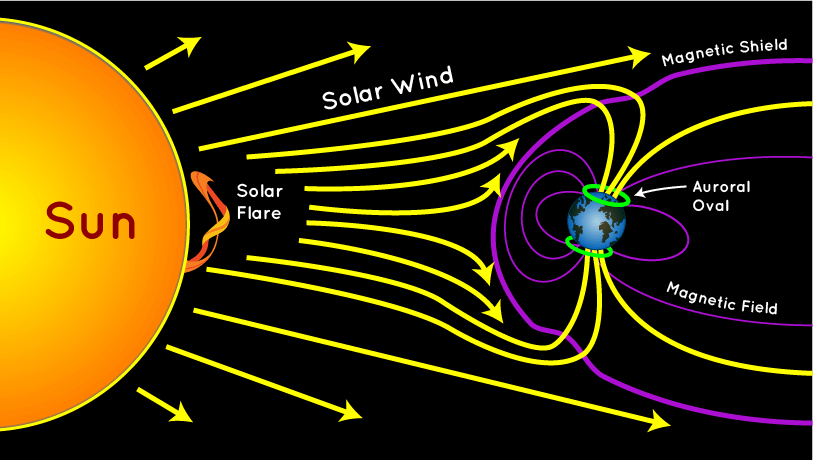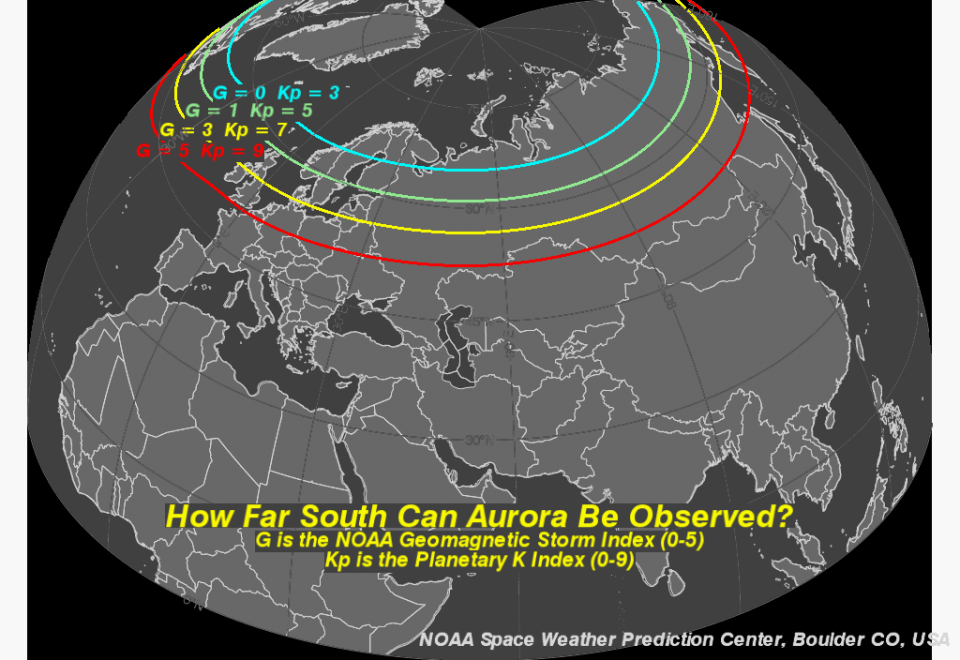



Weather: It's simple, if the sky isn't clear at your location, there is no chance you can see the phenomenon in Ireland (as clouds are between 2.5km-9 km in altitude). Basically, clouds veil the light show. So, clear skies with minimal cloud cover are essential to see the Aurora. Ireland is infamous for its temperate maritime climate and we are amongst the cloudiest regions on earth. However, don't let this put you off because if luck is on your side it is possible to see Aurora Borealis in the right conditions. (There are of course countries such as Norway where you have a much better chance to see the Aurora, but as we said, if you live in Ireland or happen to be here during a solar storm, you will need to keep an eye on the cloud cover!)
Solar Weather: It is important to understand that the Aurora is caused by a solar flare from the sun blowing towards earth (solar storm). During these storms, the sun will release solar winds that will travel through space and reach the Earth in 1-4 days. The earth's magnetic field acts as a shield to deflect the solar winds, but, at the North and South poles, some of the winds are let through. This creates the dancing lights in the sky (North = Aurora Borealis, South = Aurora Australis).
The phenomenon generally occurs between 100-300km altitude but can extend to 90-600km altitude. So, the Aurora will only appear after a solar storm but how do we know when these are happening? Space Weather centers provide us what we call “Kp Index” (Planetary K Index). Kp values range from 0 to 9 and indicate the strength of a Solar Storm. To be able to see Aurora Borealis in Ireland we need a of 5-6 minimum .


So, having confirmed we have the minimum Kp Index required (Kp5+), the best time of day to see the aurora is the night is darkest (between 9pm-2am). November and February are the darkest months and sightings are not possible from May to mid-August. The strongest Northern light activity occurs around the equinoxes (this is when the earth's axis is not tilted toward/away from the sun but is 'parallel' in a way to the sun). The spring (March) and autumn (September) equinoxes create optimal conditions for auroral storm cycles. This leads to a greater possibility of seeing the phenomenon. This year (2023) there were many sightings nationwide in Ireland during the month of April largely due to a combination of clear skies and strong solar activity.
It is true that the further north you go in Ireland, the better chance you have to see the lights (it's all about Northern Lights after all). We recommend going to Donegal, Derry and Antrim if you can. The most important factor to consider when choosing a location to view the lights, is the light pollution in that area. Big cities are not ideal due to heavy light pollution (street lights, tall buildings, cars…). Therefore, you need to find a spot that is isolated enough but also accessible.Coastal areas and lakes are a good spot as it can help you to create effects with the reflection on the water but meadows, hills and historical areas such as castles are also great options.
Here are some great spots : Giant's Causeway (our personal favourite), Malin Head (the furthest North), Ballyhiernan Bay, Ballyhoorisky (Monument and beach at Ballyhoorisky Point), Gortnalughoge/Melmore there's a camping site there and Crocknasleigh Mountain, The Ross, Tramore, Magheraroarty.
[In the future we plan to host listings for ideal accommodations here]
In summary, the further north the better, although incredible images have been captured from Kerry (South), Waterford (South-East), Connemara (West) and even coastal Dublin!
It is possible to capture stunning photos of the Northern Lights with just a phone camera but we do recommend using a camera if available - and definitely use a tripod to stabilize if you have one (but a steady hand will do!). The most important things to consider is the exposure (how long your camera will take the picture) in order to pick up the most detail and colour. We would recommend doing a quick camera test if you think you can see the lights to confirm they are present. (It is possible to see the lights with the naked eye but it also depends on each person's sensitivity.)
You won't capture images with dancing lights overhead from Ireland as our viewpoint is more 'on the horizon' (see examples in our gallery).
Smartphones allow you to take beautiful pictures thanks to the "Night Mode". The software layer already takes care of everything for you, you just need to set your exposure time (seconds) to maximum and not move at all while taking pictures and there you go! So take a deep breath, hold it and capture that magical moment!
If you are using a camera, we recommend the following tips:
Preparation is the key, test to capture the best photos!
Several colours can be observed in the Northern Lights:
Green auroras are the most common. They occur when charged particles collide with oxygen molecules at an altitude of 100-300 km.
Pink and dark red: Occasionally, the lower end of the aurora may be tinged pink or dark red. This is due to the presence of nitrogen molecules at about 100 km altitude.
Red appears higher up in the atmosphere (i.e. between 300 and 400 km altitude), collisions with oxygen atoms produce red auroras.
Blue and purple are hydrogen and helium molecules can produce blue and purple auroras. However, these hues are difficult to see with the naked eye as they are difficult to distinguish from the black of the night sky.
Facebook group Irish Aurora/NL Chasers run by John Fagan
The National Oceanic and Atmospheric Administration (NOAA) for detailed space weather information and updates.